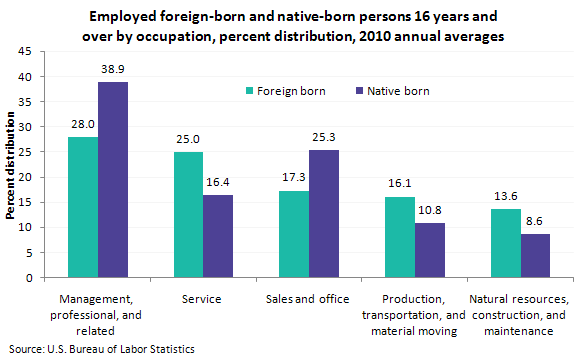Foreign-born Workers Find More Jobs in Physically Demanding Work Sector
The following pie graph may appear a bit deceptive at first. At first glance, it seems like foreign-born workers are an equal percentage of the workforce as workers born in the United States. As you examine the graph closely, you will see that the Bureau of Labor Statistics is simply comparing the occupations of both native and non-native workers.
The figures suggest that native-born workers are much more likely to avoid physical labor. These workers dominate the managerial and office jobs. Native-born workers were more likely than foreign-born workers to be employed in management, professional, and related occupations (38.9 versus 28.0 percent), and in sales and office occupations (25.3 versus 17.3 percent).
Foreign-born workers are more likely to find work in more physically demanding jobs such as construction, production, and service industries. In 2010, foreign-born workers were more likely than native-born workers to be employed in service occupations (25.0 versus 16.4 percent); in production, transportation, and material moving occupations (16.1 versus 10.8 percent); and in natural resources, construction, and maintenance occupations (13.6 versus 8.6 percent).
All of this physical work is not borne only by men. Foreign-born women were more likely than native-born women to work in service occupations and in production, transportation, and material moving occupations.
Although these statistics include all foreign-born workers, many of whom are citizens, it is worth considering how workers without citizenship cope with the inevitable problems that accompany body-centric work.


